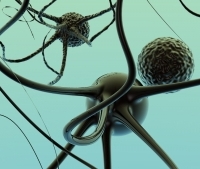Supercomputer Provides Crucial Information for HIV Research

After years of research into the chemical structure of HIV in hopes of unlocking a way to eradicate the virus, a potential key has been provided by a supercomputer.
Scientists have long been examining HIV’s protein casing, or capsid, which protects the virus’s genetic material, delivers that material into new host cells, and weakens an infected person’s immune system. In short, the capsid is the gatekeeper and propagator of the virus to defeat.
Consequently, the capsid has been the target of antiretroviral drugs, but it is made up of more than 1,300 identical proteins forming an asymmetrical cone-like shape, making it nearly impossible for researchers to unravel the complex subatomic structure.
Their solution: Turn to a computer. Blue Waters, a new supercomputer at the National Center for Supercomputing Applications at the University of Illinois, is an 11.5 petaflop machine, meaning it can perform almost 12 quadrillion floating-point operations per second. Researchers fed electron microscopy data from lab experiments into the 49,000 AMD CPUs. After some serious number crunching, Blue Waters broke down the HIV capsid into subatomic detail, revealing the virus’s building blocks.
"This is a big structure, one of the biggest structures ever solved," said University of Illinois physics professor Klaus Schulten, who worked on molecular research for the project. "It was very clear that it would require a huge amount of simulation—the largest simulation ever published—involving 64 million atoms."
Millions of computations ran simultaneously and were assisted by Tesla GPU accelerators that rapidly process large numbers of computations in parallel, said Sumit Gupta, general manager of the Tesla Accelerated Computing business unit at Nvidia. A CPU-only system would be too large, and the various simulations would have taken too much time to process.
The research team revealed the complete capsid structure May 30, 2013, in the journal Nature. Structural biology professor Peijun Zhang, who led the project and coauthored the study, explained the discovery’s significance:
The capsid is critically important for HIV replication, so knowing its structure in detail could lead us to new drugs that can treat or prevent the infection. …The capsid has to remain intact to protect the HIV genome and get it into the human cell. But, once inside, it has to come apart to release its contents so that the virus can replicate. Developing drugs that cause capsid dysfunction by preventing its assembly or disassembly might stop the virus from reproducing.
It should be only a matter of time before treatment is developed that will render HIV a thing of the past—all thanks to information provided by a supercomputer.
Said Irene Qualters, National Science Foundation program manager for Advanced Cyberinfrastructure:
The sustained petascale performance of Blue Waters is precisely what enabled these talented researchers to explore new methods combined with structural and electron microscopy data to reliably model the chemical structure of the HIV capsid in great detail. ...This knowledge will allow researchers to infiltrate that membrane with HIV-fighting drugs.

